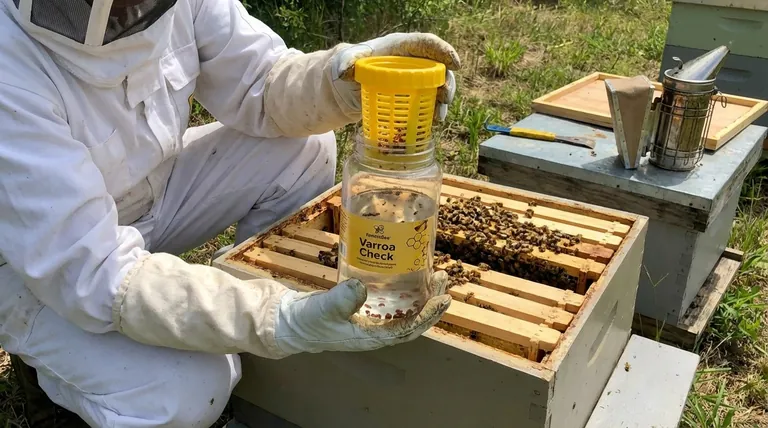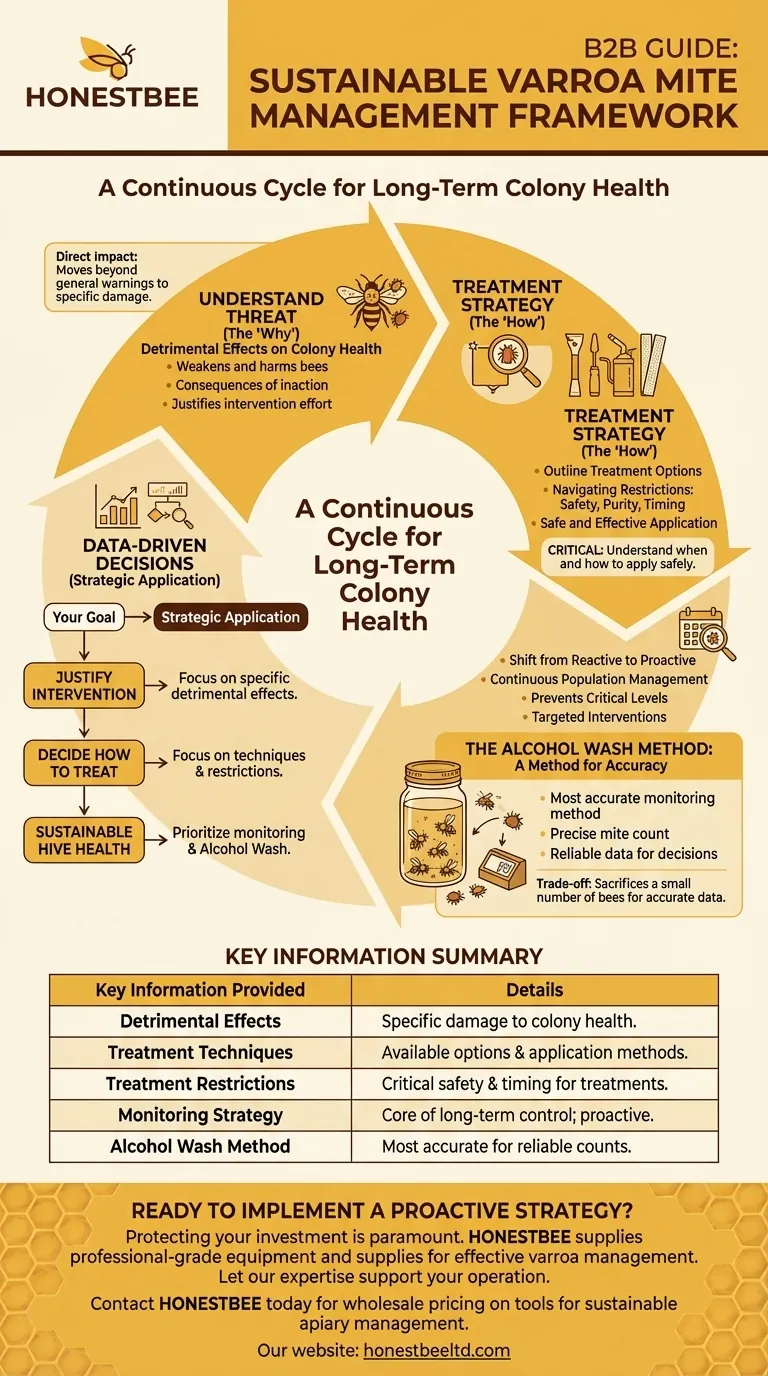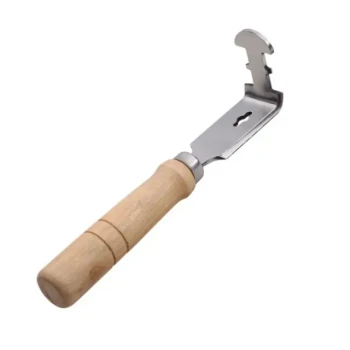In addition to identifying the threat, the guide provides a complete framework for managing varroa mite populations over the long term. It outlines the specific damage mites cause, explains available treatment techniques and their associated restrictions, and establishes population monitoring as the core of a sustainable management strategy. One specific, highly accurate monitoring method detailed is the alcohol wash.
The guide's central principle is that effective varroa mite control is not a single event but a continuous cycle. It requires understanding the impact of mites, knowing your treatment options, and consistently monitoring populations to make informed decisions.

Understanding the "Why": Detrimental Effects
The guide begins by establishing the clear and present danger that varroa mites pose to a honey bee colony. This context is critical for justifying the effort required for treatment and monitoring.
The Direct Impact on Colony Health
The guide describes the specific detrimental effects of an infestation. It moves beyond a general warning to detail how mites weaken and harm bees, ensuring the beekeeper understands the consequences of inaction.
The Strategic "How": Treatment Techniques
Once the threat is established, the guide provides the practical tools for intervention. This section is focused on the methods used to reduce mite populations within the hive.
Outlining Treatment Options
The guide presents the various techniques available for treating an infestation. This allows a beekeeper to see the range of potential solutions they can deploy against the mites.
Navigating Treatment Restrictions
Crucially, the guide also outlines the restrictions associated with these treatments. This is vital information for ensuring bee safety, honey purity, and the overall effectiveness of the chosen method, highlighting when and how a treatment can be safely applied.
The Foundation of Control: Long-Term Monitoring
The guide presents monitoring not as an optional step, but as the fundamental practice for successful, long-term mite management. It educates beekeepers on how to shift from a reactive to a proactive strategy.
From Reaction to Management
By emphasizing monitoring, the guide teaches beekeepers to manage mite populations continuously. This prevents infestations from reaching critical levels and allows for more targeted, timely interventions.
The Alcohol Wash: A Method for Accuracy
The guide recommends the alcohol wash as the most accurate monitoring method. This process involves collecting a sample of bees in alcohol, which dislodges the mites for an easy and precise count, providing reliable data to inform treatment decisions.
Understanding the Trade-offs
Effective management requires acknowledging the costs and benefits of different approaches. The guide provides the information necessary to make these calculated decisions.
The Cost of Accuracy
While the alcohol wash is presented as the most accurate method, it requires sacrificing the bees in the sample. This presents a clear trade-off: a beekeeper must decide if the value of highly accurate data outweighs the loss of a small number of bees for the greater good of the colony.
Making the Right Choice for Your Apiary
The information in the guide is designed to be applied strategically based on your specific goals as a beekeeper.
- If your primary focus is justifying intervention: The guide provides the necessary context on the specific detrimental effects of varroa mites on your colonies.
- If your primary focus is deciding how to treat: The guide outlines available techniques and, critically, the restrictions you must follow for safe and effective application.
- If your primary focus is sustainable hive health: The guide directs you to prioritize monitoring, presenting the alcohol wash as the most accurate method for making data-driven decisions.
Ultimately, the guide equips beekeepers to move beyond reactive treatments and implement a sustainable, long-term management strategy for their hives.
Summary Table:
| Key Information Provided | Details |
|---|---|
| Detrimental Effects | Details the specific damage mites cause to colony health. |
| Treatment Techniques | Outlines available treatment options and their application. |
| Treatment Restrictions | Explains critical safety and timing restrictions for treatments. |
| Monitoring Strategy | Establishes population monitoring as the core of long-term control. |
| Alcohol Wash Method | Details the most accurate method for reliable mite population counts. |
Ready to implement a proactive varroa mite management strategy?
As a commercial beekeeper or distributor, protecting your investment is paramount. HONESTBEE supplies the professional-grade equipment and supplies you need to effectively monitor and treat for varroa mites, ensuring the long-term health and productivity of your hives.
Let our expertise support your operation. Contact HONESTBEE today to discuss wholesale pricing on the tools for sustainable apiary management.
Visual Guide

Related Products
- Varroa Easy Check Mite Tester Kit Counter Alcohol Wash Jar
- Adjustable Formic and Acetic Acid Dispenser for Bee Mite Treatment
- Black Plastic Beetle Barn Hive Beetle Trap for Beehives
- Extra Wide Stainless Steel Honey Uncapping Fork with Scraper Beekeeping Tool
- Steam Beeswax Melter Wax Warmer for Wax Processing
People Also Ask
- What are some popular methods to measure Varroa mite load in beehives? Compare Accuracy & Bee Safety
- How is the infestation percentage calculated after counting mites? Master Varroa Mite Monitoring
- What is the most reliable method for assessing Varroa mite infestations? Master Proactive Hive Management
- How often should varroa mite checks be performed using the alcohol wash method? Optimize Your Apiary's Health
- What is the most accurate method for monitoring varroa mites? The Definitive Guide for Beekeepers



















